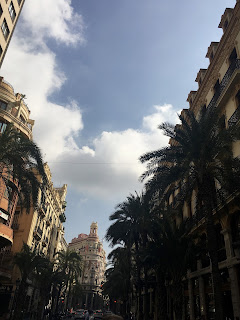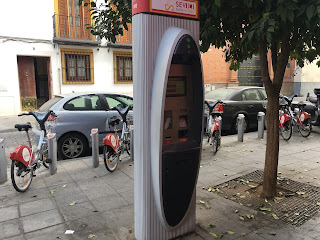
Last weekend I visited Granada with two friends from my program in Sevilla, Rebecca and Camila. One of my friends from Carleton is currently studying in Granada, and the entire Carleton Madrid program was also visiting Granada, so I planned our visit to be able to meet up with everyone. Just like the previous weekend in Valencia, it was so fun to see friends from home.
Granada is a few hours from Sevilla by bus, also in the Andalucía region of Spain, and is such a cool city. Unlike Sevilla, Granada has elevation and hills, with clear views of snow-capped Sierra Nevada mountains. Granada was the last Arab city in the region to be conquered by the Catholic Monarchs, and as such, retains significant Arab influence, in the form of food and art and culture. And Granada somehow seems to be more laid-back and colorful than Sevilla, with loads of street art and political graffiti (Sevilla doesn't feel very politically involved). I was really, really into the city's vibes.
When my friends and I first started planning our trip to Granada, my host dad told me that we absolutely had to go to La Alhambra. Not knowing anything about it and having only seen a few photos, I responded something along the lines of, "I mean we've already been to the Alcazar in Sevilla, isn't it the same thing?" My host father was visibly astonished and the entire family couldn't believe what I'd said; a very passionate and convincing discussion ensued.
Ultimately, we knew that we'd have to visit La Alhambra (a UNESCO World Heritage Site, and apparently one of the most popular tourist stops in Europe). Unfortunately, when we tried to prebook our tickets a few weeks in advance, everything was already sold out. I read online that same day tickets could be purchased if we showed up to wait in line at 6:30am, fingers crossed that they wouldn't run out. So that became our game plan for getting into La Alhambra.
Our first afternoon in Granada was spent exploring with my friend Caroline, who showed us around the city where she lives. Great food, including the best churros we've had in Spain (went back the next day). We met up with my other Carleton friends at night (Saul, Sylvie, Dallas; see previous post). At 2:30am I set my alarm for 5:55am.
When we finally woke up we made a lovely egg brunch (I cooked so much kale!) and re-evaluated our day. We spent the entire day walking around Granada, seeking out street art, and enjoying the beautiful views. I loved it. We even found a tiny Colombian take-away restaurant, which was joyful for everyone involved. Most definitely could have seen myself studying in Granada.
After a dinner of free tapas with Carleton friends, Rebecca, Camila, and I spent an intense hour trying to purchase tickets to La Alhambra while walking across Granada. We gave up and resigned ourselves to missing the world-renowned Arab palace. We were only finally successful with one last attempt, once we were at the discoteca dancing ourselves silly.
Sunday morning we rolled out of bed, made more eggs, and climbed back up the hill to the Alhambra. The entire journey there was surreal, since due to the chain of events, none of us could believe that we were actually going to visit. The Alhambra was beautiful. An ancient Arab royal palace and fortress, on a hill overlooking the city, with extensive palatial gardens. Unbelievably intricate decoration and tile work. Columns, fountains, flowers, and colors. It was expanded by different Islamic rulers throughout time, each addition following the theme of paradise. (Fun fact, La Alhambra was occupied by squatters after centuries of neglect, before being rediscovered and converted to present-day World Heritage Site.) I can't at all describe it, so please look at the photos and know that it was at least 12x better than I could capture. I highly recommend. Once we'd filled up on beauty, we hiked back down into town and boarded a bus back to Sevilla.





